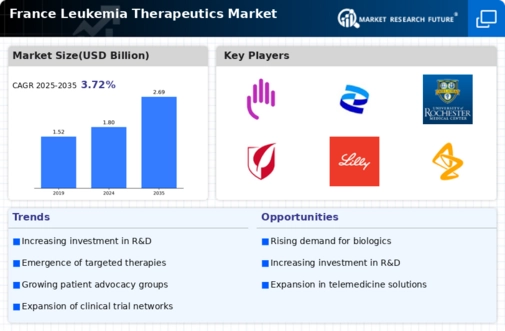Advancements in Biotechnology
Technological advancements in biotechnology are transforming the landscape of the leukemia therapeutics market. Innovations such as CAR-T cell therapy and monoclonal antibodies have shown promising results in treating various types of leukemia. In France, the biotechnology sector is experiencing robust growth, with investments in research and development reaching approximately €1.5 billion in 2025. These advancements not only improve treatment efficacy but also reduce side effects, making therapies more appealing to patients and healthcare providers. The integration of personalized medicine, driven by genetic profiling, is also gaining traction, allowing for tailored treatment plans that enhance patient outcomes. As these biotechnological innovations continue to evolve, they are expected to play a crucial role in shaping the future of the leukemia therapeutics market.
Growing Incidence of Leukemia
The rising incidence of leukemia in France is a pivotal driver for the market. Recent statistics indicate that leukemia accounts for approximately 3% of all cancer cases in the country, with an estimated 10,000 new cases diagnosed annually. This increasing prevalence necessitates the development and availability of effective therapeutic options. As the population ages, the likelihood of leukemia cases is expected to rise, further propelling the demand for innovative treatments. The healthcare system in France is adapting to this trend by allocating more resources towards leukemia research and treatment, which is likely to enhance patient outcomes. Consequently, the growing incidence of leukemia is a significant factor influencing the expansion of the leukemia therapeutics market, as stakeholders seek to address the urgent need for effective therapies.
Increased Awareness and Screening Programs
There is a growing awareness of leukemia and its symptoms among the French population, which is positively impacting the leukemia therapeutics market. Public health campaigns and educational initiatives have led to improved screening and early detection rates. As a result, more individuals are being diagnosed at earlier stages, which is crucial for effective treatment. The French government has invested in screening programs, aiming to increase early diagnosis rates by 20% by 2026. This heightened awareness not only facilitates timely intervention but also drives demand for therapeutic options. Consequently, the increased awareness and screening programs are vital components influencing the growth of the leukemia therapeutics market, as they contribute to better patient outcomes and a more informed public.
Regulatory Support for Innovative Therapies
Regulatory bodies in France are increasingly supportive of innovative therapies, which is a key driver for the leukemia therapeutics market. The French National Agency for Medicines and Health Products Safety (ANSM) has streamlined the approval process for new treatments, particularly those that demonstrate significant clinical benefits. This regulatory environment encourages pharmaceutical companies to invest in the development of novel therapies, including gene therapies and immunotherapies. In 2025, it is anticipated that the approval of several new drugs will further enhance treatment options for leukemia patients. The proactive stance of regulatory agencies not only accelerates the availability of cutting-edge therapies but also fosters a competitive market landscape, ultimately benefiting patients and healthcare providers alike.
Collaboration Between Public and Private Sectors
Collaboration between public and private sectors is emerging as a significant driver for the leukemia therapeutics market. In France, partnerships between government agencies, research institutions, and pharmaceutical companies are fostering innovation and accelerating the development of new therapies. These collaborations often focus on shared research initiatives, funding opportunities, and clinical trials, which enhance the overall efficiency of the drug development process. In 2025, it is projected that such partnerships will lead to the introduction of several new therapies, addressing unmet medical needs in leukemia treatment. This synergy not only enhances the therapeutic landscape but also ensures that patients have access to the latest advancements in care. Thus, the collaboration between public and private sectors is a crucial factor shaping the future of the leukemia therapeutics market.

























Leave a Comment